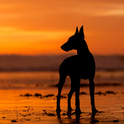Whippet
This is inbreeding (homozygosity) measured directly from DNA. The green line is at 6%, the average inbreeding of a litter produced by first cousins. Yellow (12%) is the inbreeding produced by half-siblings, and red (25%) is the average inbreeding produced by a sib-sib cross. (These are predicted averages; puppies in the litter can vary a lot above and below this just depending on what genes they happen to inherit).
This a scan of "runs of homozygosity" (ROH) that allows you to see where on the chromosomes there are large blocks of inbreeding. (There is info about how to interpret these plots HERE.)
The first panel is ROH for large blocks (5000 kb) of homozygosity. These represent "recent" inbreeding (i.e., last 6 or 8 generations). On page 2 of the tutorial, there are 3 panels per breed - at 70kb, 1,000kb, and 5,000kb; so this panel is comparable to the third one in each set.
Whippets are quite inbred: the inbreeding coefficient (from above) is > 30%, greater than the level of inbreeding you would get from a cross of full siblings from unrelated parents. From the first panel of scans, you can see that thre is a lot of recent inbreeding (top panel); the bottom panel includes both old and new inbreeding.
This panel is scans for 70kb blocks (the first panel in the sets of three in the tutorial). This shows both recent and ancient (hundreds of generations, so before breed formation) inbreeding.




